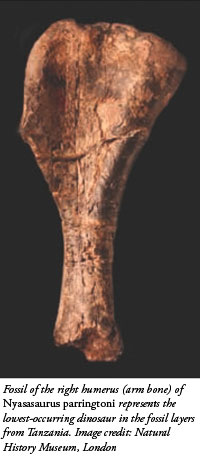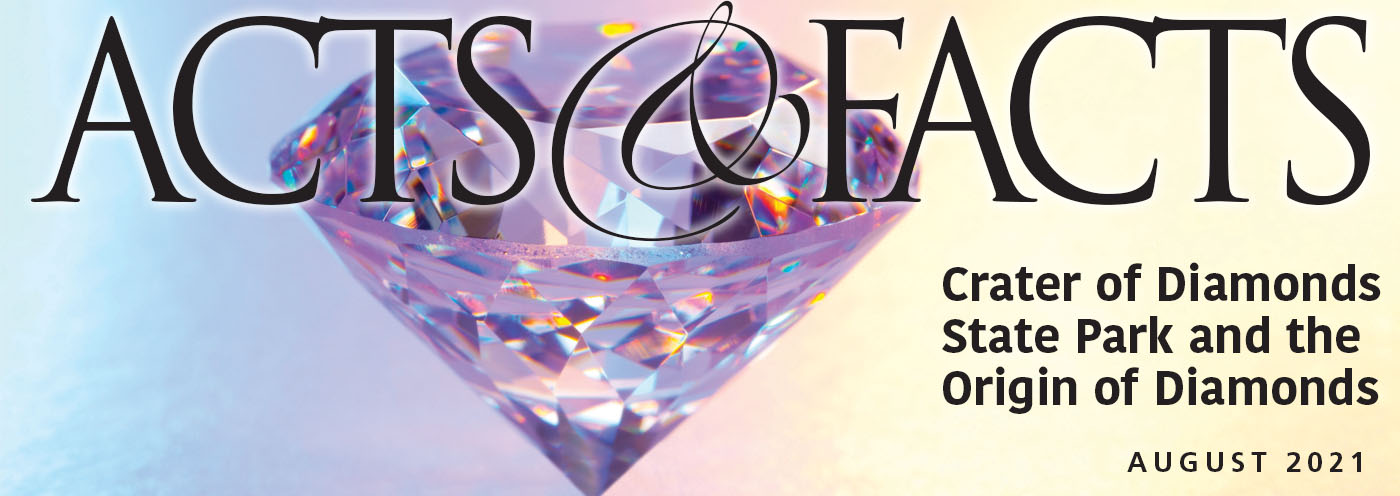A portion of a fossilized dinosaur upper arm bone from Tanzania, originally collected in the 1930s, spent many years nestled among thousands of dinosaur specimens housed at London's Natural History Museum. Re-examined, researchers now claim that it is the oldest dinosaur—or almost a dinosaur—in the world.
Well, was it a dinosaur or not?
The arm bone segment is associated with fossil vertebrae, or spinal bones, from the same species named Nyasasaurus parringtoni. The vertebrae were held in Iziko South African Museum in Cape Town while the arm bone was in London. Researchers published their analysis, which visualized bones under a microscope, in Biology Letters.1 Taken together, the arm and spine fossils convinced the team that they were looking at dinosaurian bones, and yet they hesitated to confidently identify them as dinosaur.
"It is possible that instead of being a true dinosaur, Nyasasaurus might have been a very close relative, lying just outside the dinosaur group," according to the Natural History Museum.2
Why are they unsure? After all, the bones show "very distinctive" dinosaur features, including a "prominent crest" on the arm bone where a strong muscle would have attached and spaces for large blood vessels in the vertebrae to facilitate the fast bone growth characteristic of dinosaurs.2 The identification problem is not in the fossils, so where is it?
The unique character combination of Nyasasaurus may represent the plesiomorphic states [similar traits shared among less similar kinds] present just outside or within Dinosauria given its age, but there are considerable uncertainties.2
Clearly, the uncertainties arise "given its age," but Nyasasurus' age is based on evolutionary belief, not science. Within this scheme, true dinosaurs should not be found this far below other fully formed dinosaurs because they were not yet supposed to have evolved.
The researchers are uncertain as to whether or not it is a dinosaur, what pre-dinosaurs may have looked like, or how this dinosaur—or most others found in congruent rock layers—relates to other dinosaur forms within evolutionary assumptions.
All these uncertainties arise from evolutionary doctrine, not from dinosaur data.
The study authors compared the humerus bone with others, finding that it best matches theropods—dinosaurs with lizard-like hips and three toes. According to the Natural History Museum, a well-known dinosaur that's attributed to much "younger" rock layers "is the early dinosaur Eoraptor, which Nyasasaurus may have looked like."2 If it looks like a theropod, why not just call it a theropod?
Clearly that would not fit evolutionary teaching, which predicts that pre-theropod ancestors (an uninhabited category) should be found below theropods, and that even more generalized pre-dinosaurs should be found below the pre-theropods in Nyasasaurus layers.
Instead, they got a well-formed theropod at the very bottom of the dinosaur fossil record.
So, to keep evolution's plausibility, the Current Biology authors nursed the idea that Nyasasaurus could have been almost a dinosaur despite its perfectly dinosaurian anatomy.
In contrast, how well would the creation and Flood model of earth history and rock layers explain Nyasasaurus?
First, as a beast of the earth created on Day Six of the world, it should already be in a recognizable dinosaur form—and it is.3
Second, as a creature that drowned in the Flood of unprecedented catastrophe, instead of scavenged or rotten on earth's surface, its remains had a chance to be fossilized—and they were.
Third, as a creature that may have lived in a swampy environment—not a sea creature nor a dry land walker—it was buried above layers that contain mostly sea creatures deposited earlier during the Flood.
All the "considerable uncertainties" in interpreting the Nyasasaurus find their source in the uncertain and untrue doctrines of evolution.4
References
- Nesbitt, S. J. et al. The oldest dinosaur? A Middle Triassic dinosauriform from Tanzania. Biology Letters. Published online before print, December 5, 2012.
- Fossils could be first dinosaur to roam planet. Natural History Museum News. Posted on nhm.ac.uk December 5, 2012, accessed December 6, 2012.
- This illustrates an irony. On the one hand, researchers were able to reconstruct the general theropod dinosaur form by making valid inferences from the shapes of a few of its bones, assuming that the bones would have fit in a proper and practical arrangement. But on the other hand, co-author Paul Barrett told the Natural History Museum, "Dinosaurs started as just one of a number of evolutionary experiments in reptile evolution."2 If Nyasasaurus was just an early evolutionary experiment, then why would Barrett expect its bones to be in any proper arrangement? Within the evolutionary worldview, there should be no reliable way to reconstruct ancient bones undergoing experimental size and proportion adjustments. Thus the irony: Researchers had to borrow from the creation worldview's idea of well-formed kinds in order to do their evolutionary research.
- Thomas, B. 2012. Four Scientific Reasons That Refute Evolution. Acts & Facts. 41 (5): 17.
Image credit: Copyright © 2001 Museum of Natural Sciences, National University of San Juan, Argentina. Adapted for use in accordance with federal copyright (fair use doctrine) law. Usage by ICR does not imply endorsement of copyright holders.
* Mr. Thomas is Science Writer at the Institute for Creation Research.
Article posted on December 14, 2012.

















